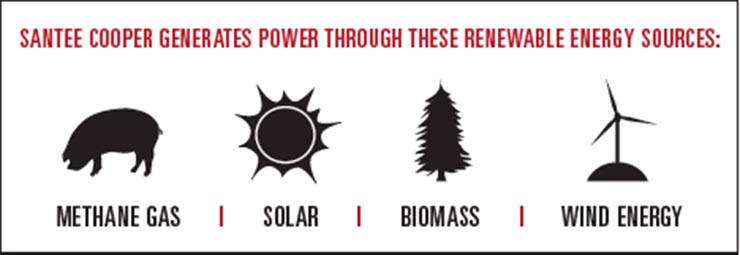Home > South Carolina > South Carolina Environment > Santee Cooper Uses Natural Resources for Renewable Power
Santee Cooper Uses Natural Resources for Renewable Power

Among the methods that Santee Cooper uses for generating power, there is one that would be particularly considered a win-win by company officials.
The state-owned electric and water utility company, South Carolina’s largest power producer, has been using methane gas from landfills for an energy source since 2001. Santee Cooper now has six facilities across the state using gases emitted from landfill sites to produce electricity.
“Methane gas, of course, is a very potent and harmful greenhouse gas,” says Mollie Gore, public relations director for Santee Cooper, “and by pulling it out of the atmosphere and using it to generate electricity, it’s a double win.
“You’re removing something harmful for the environment and you’re able to recycle it as a fuel source for electricity.”
Landfill gas is one of several renewable energy resources Santee Cooper has been using for the past 12 years. It’s the state’s leader in generating electricity from renewable methods, with 151 megawatts already online or under contract.
Solar has been in use since 2006, and research is ongoing in efforts to make the method more efficient and to lower costs, Gore says. A demonstration wind turbine is located in North Myrtle Beach for research on offshore wind power, but it’s not currently a viable resource for inland South Carolina.
However, in addition to its use of landfill gas, Santee Cooper is providing power from renewable resources that might be less known than solar and wind. Two others are woody biomass and anaerobic digesters, which fall under the broad category of biomass. This is a method in which renewable energy sources come from living or recently living organisms.

“We have contracted with several independent power producers to take forest residue and generate electricity, which we are in turn buying from them,” Gore says of the company’s use of woody biomass. “When they’re all up and running, it will be the largest part of our renewable generation.”
Santee Cooper also partnered with Environmental Fabrics Inc., an environmental construction firm in Columbia, to build the state’s first anaerobic digester facility. It is located on a hog farm in Williamsburg County, where it converts methane gas to electricity. Two other facilities are planned.
Santee Cooper’s production of electricity from renewable resources falls under the classification of Green Power. The company is certified by Green-e, meaning that all the power produced from renewables meets strict and specific national environmental standards. The company also sells Green Power on a voluntary basis, and 100 percent of the money is put back in renewable generation.
“Our philosophy for developing renewable energy resources is that it needs to make sense for our customers,” Gore says. “It’s important that we can do it without creating a cost burden to customers.”



